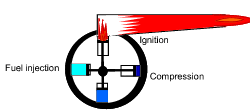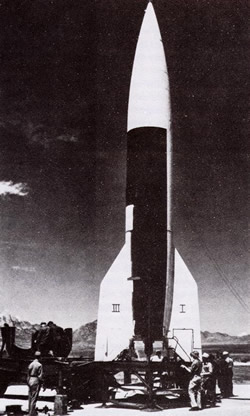long range missile.


Most fighter aircraft were too slow to intercept a V1 missile and anti-aircraft gunners found it hard to hit such small, fast moving objects.
The animation on the right shows how a pulse jet works. The pulse jet differs from other jet engines in that combustion inside the engine is not continuous but occurs in repeated explosions.These repeated explosions give the engine its characteristic buzz noise. One-way valves control the flow of air and fuel into the ignition chambers. Upon ignition these valves slam shut, forcing the gases to escape through the tailpipe generating thrust.

The awesome V2 rocket was the first intercontinental ballistic missile ever to be launched. Its use marked a new era in modern warfare. The V2 was fuelled by a mixture of ethanol and liquid oxygen. It was recognised as a revolutionary invention with uses far beyond the battle fields of Europe. Its superior technology and power provided the stepping stone for mankind to conquer space.
V2 technology gave the Russian's
the means with which to put mankind's first sattelite (Sputnik) into Earth
orbit in 1957. Click to see a 240 kb video.
Four years later in April 12 1961 Yuri Gagarin became the first human
in space. Intense rivalry between the old USSR and the USA caused Kennedy
administration to devote millions of dollars to the ambitious project
of landing a human on the Moon. This feat was accomplished on July 21
1969 when Neil Armstrong landed on the moon. By 1971 the Russians had
a permanent, manned, orbiting space station called Salyut.
